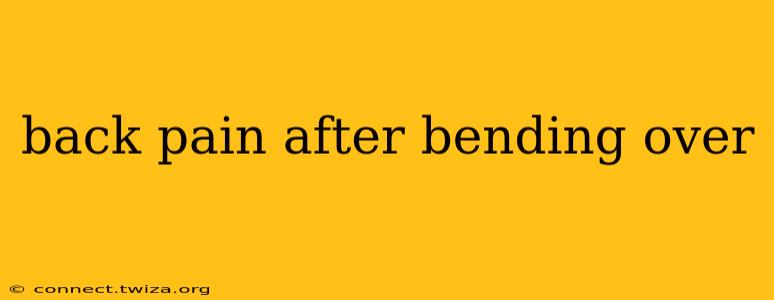Back pain after bending over is a common complaint, affecting people of all ages and activity levels. While often temporary and resolving on its own, understanding the underlying causes is crucial for effective management and prevention. This comprehensive guide explores the various reasons why you might experience back pain after bending, offering insights into diagnosis, treatment, and strategies to minimize future occurrences.
What Causes Back Pain After Bending Over?
The pain you feel after bending can stem from a variety of sources, ranging from minor muscle strains to more serious conditions. Here are some of the most common culprits:
-
Muscle Strains: This is the most frequent cause. Bending, especially if done improperly or repeatedly, can overstretch or tear muscles in your back, leading to pain, stiffness, and limited movement. This is especially true if you're lifting heavy objects while bending.
-
Ligament Sprains: The ligaments that support your spine can also be injured by bending, resulting in pain and instability. This is often accompanied by swelling and tenderness.
-
Disc Problems: Intervertebral discs act as cushions between your vertebrae. Bending, particularly with twisting, can put pressure on these discs, potentially causing a herniated disc (where the gel-like center pushes out), leading to significant pain that can radiate down your leg (sciatica).
-
Facet Joint Problems: The facet joints are located between your vertebrae and help guide movement. Degeneration or inflammation in these joints (often due to age or overuse) can cause pain exacerbated by bending.
-
Spinal Stenosis: This condition involves narrowing of the spinal canal, putting pressure on the nerves. Bending can worsen the pressure and increase pain.
-
Osteoarthritis: This degenerative joint disease can affect the spine, causing pain and stiffness that are often worse after bending.
-
Other Conditions: Less common causes include fractures, tumors, and infections of the spine. These require immediate medical attention.
How Is Back Pain After Bending Diagnosed?
Your doctor will begin with a thorough physical examination, assessing your range of motion, posture, and neurological function. They will ask detailed questions about your pain, including its location, intensity, duration, and any activities that aggravate or relieve it. Imaging studies, such as X-rays, MRIs, or CT scans, may be necessary to rule out more serious conditions like fractures, herniated discs, or spinal stenosis.
How Is Back Pain After Bending Treated?
Treatment depends on the underlying cause and severity of your pain. Many cases resolve with conservative management, including:
-
Rest: Avoid activities that aggravate your pain.
-
Ice and Heat: Applying ice initially can help reduce inflammation, while heat can soothe muscle stiffness later on.
-
Over-the-Counter Pain Relievers: Medications like ibuprofen or acetaminophen can help manage pain and inflammation.
-
Physical Therapy: A physical therapist can teach you exercises to strengthen your back muscles, improve flexibility, and improve your posture.
-
Chiropractic Care: Chiropractic adjustments may help alleviate pain by addressing joint misalignments.
In more severe cases, your doctor may recommend:
-
Corticosteroid Injections: These injections can reduce inflammation and pain in the affected area.
-
Epidural Steroid Injections: These injections target the nerves in your spine, providing pain relief.
-
Surgery: Surgery is rarely necessary for back pain after bending, but it may be considered in cases of severe disc herniation, spinal stenosis, or other serious conditions.
What Can I Do to Prevent Back Pain After Bending?
Prevention is key! Here are some strategies to minimize your risk of back pain after bending:
-
Proper Lifting Techniques: Always bend at your knees and hips, keeping your back straight, when lifting heavy objects. Keep the object close to your body.
-
Maintain Good Posture: Good posture helps support your spine and reduces strain on your back muscles.
-
Strengthen Your Core: Strong core muscles provide stability and support for your spine. Regular exercise, including planks, sit-ups, and other core-strengthening exercises, is essential.
-
Stretch Regularly: Stretching helps maintain flexibility and prevents muscle stiffness. Focus on stretches for your back, hamstrings, and hips.
-
Maintain a Healthy Weight: Excess weight puts extra strain on your back.
-
Ergonomic Workplace: Ensure your workstation is ergonomically designed to support good posture.
What are the different types of back pain?
Back pain can be categorized in several ways, including by its location (upper, middle, or lower back), its duration (acute, subacute, or chronic), and its cause (mechanical, inflammatory, or neuropathic). The pain after bending can be acute (sudden onset) or chronic (lasting more than three months), and the cause may range from a simple muscle strain to a more complex condition like a herniated disc.
How long does back pain after bending last?
The duration of back pain after bending varies greatly depending on the cause and severity of the injury. For minor muscle strains, the pain often resolves within a few days to a few weeks with rest, ice, and over-the-counter pain relievers. However, more serious conditions like herniated discs or spinal stenosis may cause longer-lasting pain, potentially requiring more extensive treatment.
When should I see a doctor about back pain after bending?
You should consult a doctor if your back pain after bending is severe, persistent (lasting longer than a few weeks), accompanied by neurological symptoms (such as numbness, tingling, or weakness in your legs or feet), or if you experience fever, weight loss, or bowel/bladder changes. These symptoms could indicate a more serious underlying condition requiring prompt medical attention.
This information is intended for educational purposes only and should not be considered medical advice. Always consult with a healthcare professional for any health concerns or before making any decisions related to your health or treatment.
